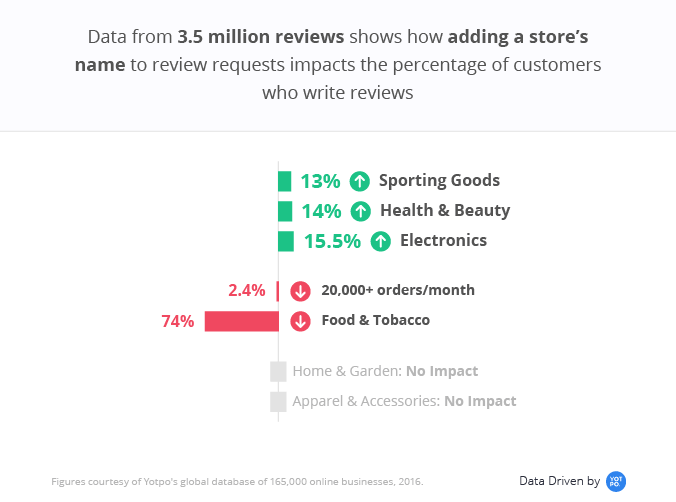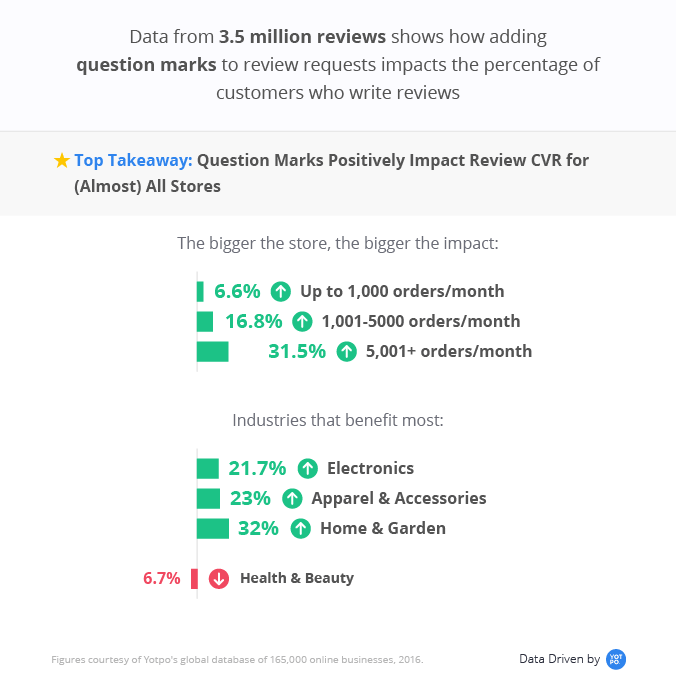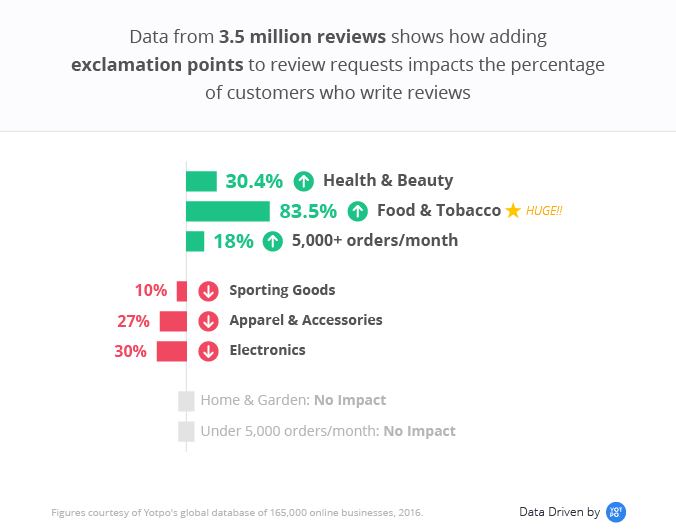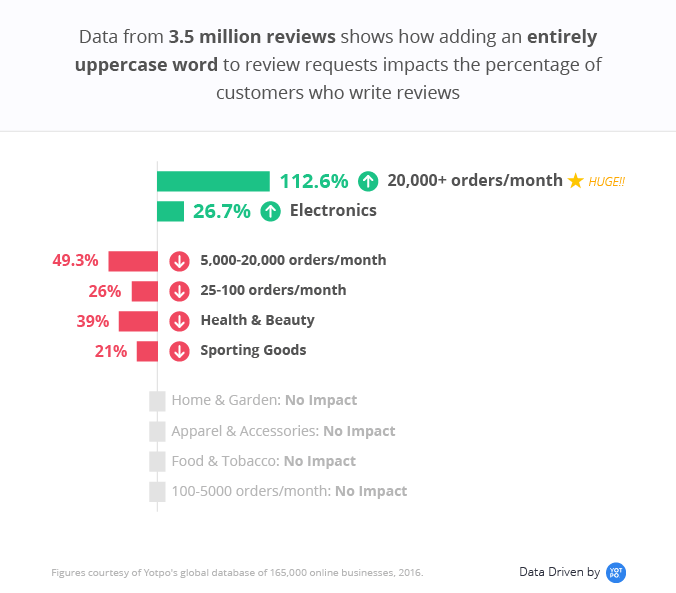While it might seem obvious, the exact science of how to ask customers for reviews can be a bit tricky at times. So, we decided to investigate what your customers see in review request emails, the messaging in SMS requests, and best practices for requesting reviews to see how it all affects review conversion. First, let’s look at the benefits of collecting reviews from customers and how it can help strengthen your brand.
The benefits of collecting customer reviews
Why do you want customer reviews in the first place? There are many benefits to having reviews on your eCommerce site, but here are just a few to keep in mind.
They provide shoppers with information, leading to more purchases
Customer reviews are seen as highly trustworthy, and they increase sales conversion rates. Potential customers like seeing user-generated content (UGC) as proof that others have bought and are satisfied with your product, which nudges them to complete their purchase.
You can collect invaluable customer feedback for actionable insights
Negative reviews show you opportunities for improvement. Use customer feedback to identify friction points in your customer experience. For example, collecting reviews from customers that include details about product fit, quality, or shipping issues, provides your brand with actionable insights to make adjustments to your products, processes, or on-site descriptions.
Reviews help with SEO and search results
Up-to-date reviews are essential for ranking highly on Google. Ranking highly on Google is essential for eCommerce marketing, especially if you’re a local business that depends on Google search results and Google Star Ratings. Getting those reviews and ratings front and center on search, and leveraging SEO, can help you stand out from the competition.
How to Ask Customers for Reviews
As you can see, small differences in your brand’s messaging can make a big impact on how customers engage with review requests, leading to more thoughtful reviews about your products and your brand in general. Here are some other stand out ways to ask for reviews:
1. Leverage omnichannel review requests
Customers are much more likely to respond to a review request on mobile devices like phones or tablets. Phones have a 7% higher conversion rate than desktops, and tablets have a 20% higher conversion rate than desktops. Structure your request for mobile experiences, and consider using SMS marketing to follow up. (CVR for SMS versus email is 66% higher!)
2. Send timely review requests
Additionally, sending review requests in a timely manner or following up with your shoppers if you haven’t received a review from your first request can help encourage customers to complete a review. It’s important that you are asking for reviews after your product has been delivered, but not too late. In this case, keeping track of shipping and delivery and then adjusting the timelines that trigger your automatic review request flows can help with this.
3. Respond to your reviews — even the negative ones
While receiving a negative review might feel difficult at first, responding to a negative review and engaging with your customers is critical. Responding to a negative review gives your brand a chance to remedy any issues the customer had with their shopping experience. This can help reduce churn, build brand trust, and incentivize customers who left a negative review to revise or change a review once any issues have been solved.
Some things to keep in mind when sending out review requests
- Stores with small monthly orders are able to convert customers into reviewers. This means small stores are at an advantage because their customers are more likely to write reviews, which is great for brands focusing on growth, as more reviews can lead to more sales.
- Negative reviews aren’t always a bad thing. Whether a product currently has negative or positive reviews doesn’t impact how many customers will review the product. As previously mentioned, negative reviews aren’t always bad for your brand; they don’t always directly impact the review request conversion rate. A few negative or critical reviews also help legitimize your positive reviews.
- Some products are more successful. Products that aren’t frequently purchased receive more reviews. Past research taught us that it’s important to have similar reviews across your products because conversion is hurt when a few products have many reviews and other products have none. So it’s good that, naturally, products that aren’t bought frequently have a higher chance of being reviewed.
Best practices for review requests: subject lines and messaging
Getting more reviews requires thoughtfulness, and small changes can have big results. With that, it’s crucial to maintain branding throughout your brand’s messaging — including subject lines when you are asking for reviews.
We studied the subject lines of 3.5 million post-purchase review request emails and compared their conversion rates to the average to find out what works and what doesn’t when asking customers for reviews. To further build off of the insights surrounding how to ask customers for reviews, let’s explore some best practices in subject lines and overall messaging.
Maintain your branding by including your store name
Adding your store or business name to the subject line does boost conversion by 3.7% on average — but sometimes, it corresponds with a significant decrease.
The industries that benefit the most from including their store name are Health & Beauty, Home & Garden, Sporting Goods, and Electronics. But Food & Tobacco brands see a big decrease (74%) if they add the store name to subject lines.
Size-wise, the stores that don’t benefit from adding their name in subject lines are stores with over 20,000 orders (-2.4%).

Connect your loyalty program to your reviews
When we first shared these findings, our data showed that offering a discount in exchange for a review was an extremely effective way to convert requests. However, new FTC regulations are requiring brands to use alternative strategies to incentivize reviews. Brands can incentivize reviews through loyalty programs, coupons (that don’t require customers to leave a positive review in order to redeem said coupons), and rewards points.
Ask your customers a question
Interestingly, the bigger the store, the more of an impact adding a question mark has. Only one industry saw negative results (Health & Beauty), but the impact is very minimal.

Use Exclamation Points (If You’re a Food or Tobacco Business!)
Exclamation points do not have a big impact in general, but there are some slight variations by store size.
In general, for stores with under 5,000 orders, exclamation points don’t exhibit a direct impact, while stores with over 5,000 orders tend to see a more positive impact (about 18%). However, for extremely small stores (under 100 monthly orders) or extremely big stores (over 100,000 monthly orders), there’s actually a slightly negative impact.
When it comes to industry, the most astonishing difference is when it comes to Food & Tobacco stores. For these stores, adding exclamations can lead to an 83.5% increase. Adding a question mark barely increased the conversion rate of a shopper to a reviewer in this industry, so it’s surprising to see what a huge impact changing punctuation to an exclamation point has.
The Food & Tobacco industry’s results are even more surprising when you consider that the second most impacted industry is Health & Beauty, which gets a 30.4% increase. That means adding exclamation points increases Food & Tobacco stores’ review conversion rate nearly three times more than any other industry!

Be mindful of capitalization and punctuation
The use of “all caps” in a subject line showed a slight decrease in the overall review conversion rate: 5.8% on average.
The only industry that benefits significantly is Electronics, which has a 26.7% increase. The industries that should definitely avoid capitalized words are Health & Beauty (39% decrease) and Sporting Goods (21%).
For stores with under 20,000 monthly orders, adding a word in all caps can lower conversion by up to 49.3%. Interestingly, stores with more than 20,000 orders see an enormous increase when they add capitalization: 112.6%!

Leverage 2-in-1 Review Requests
Brands need two types of reviews: product reviews and site reviews. The latter improves their Google Seller Rating (GSR) score, which directly impacts conversion; in fact, a high GSR can increase CVR by 17%. Instead of overloading your review request emails, use a tool like Yotpo’s 2-in-1 Review Request tool that seamlessly prompts users to leave a store rating after completing a product review.
Emotional appeals in subject lines aren’t always the go-to
Including emotional words — like love, smile, happy, help, etc. — doesn’t have a major impact overall on getting customers to leave reviews.
Interestingly, when it comes to the breakdown by store size, small stores (25-100 orders/month) and large stores (20,000+ orders/month) both see a negative impact, while medium-sized stores (between 100-20,000 orders/month) don’t see any major impact.
Industry-wise, Health & Beauty, Electronics, and Sporting Goods also see a negative impact from having emotional words in subject lines; the review conversion rate can be up to 41% lower! In contrast, Home & Garden businesses see an increase in review conversion when they include emotional keywords. The conversion rate is 28% higher on average. This could be because consumers are more emotionally attached to items they buy for their home than they are to items like computers or baseball bats.
Work with experts to enhance your review request messaging
A third party can bring experience and expertise in increasing your customer reviews. With Yotpo’s Review platform, you’ll not only bring in more feedback but can also turn it into content and leverage it to increase sales.
Review requests: email and SMS templates
Email messaging and SMS review requests work exceptionally well together when done correctly. If one channel is better suited to certain customers or customer actions, it can fill in whatever gaps the other channel has left. This provides a well-rounded and powerful marketing strategy that reaches your customers at the right moment on the correct devices.
With that, let’s take a look at some review request email templates and review request templates for SMS to elevate your engagement and increase review conversion rates. Here are a few standard templates to help you find the best way to ask customers for reviews, all of which can be slightly modified to fit your brand’s needs.
How to ask for a review: email templates
Subject line: How’s your new �product] from 3brand name]?
Email copy 1:
Hi lname],
Thank you for ordering product]! Now that you’ve had some time to use it, we would love it if you could leave a review so that other shoppers can learn from your feedback. When you can, please leave a review here elink].
Please click here to leave a review.
Thank you!
rbrand team]
Email copy 2:
Hi name],
We hope you’re loving your new eproduct]! We are always looking to improve. If you have a moment, please share your thoughts with us in a review. Other shoppers use these reviews to help shoppers like you make the right decision at checkout.
Please click here slink] to leave a review.
Thank you!
obrand team]
How to ask for a review: SMS template
SMS copy 1:
Hi kname],
We hope you’re enjoying your new lproduct]? We’re always looking to improve and would love your feedback. Please leave a review here tlink to review request]!
Thank you!
jbrand team]
When it comes to adapting this template for your needs, don’t be afraid to get creative and show your brand personality! Make sure it matches the tone you use across your site, and don’t shy away from bringing a sense of community to the copy. You can also consider including helpful information about using the product to inspire goodwill that encourages customers to take a moment to submit a review.
